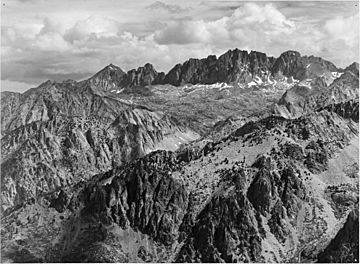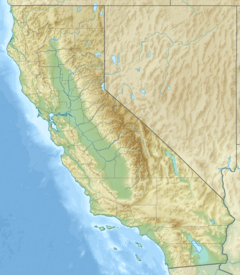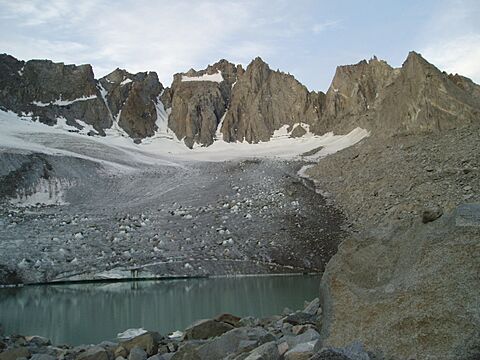North Palisade facts for kids
Quick facts for kids North Palisade |
|
|---|---|
| Starlight Peak | |

North Palisade from Windy Point (by Ansel Adams, 1936)
|
|
| Highest point | |
| Elevation | 14,248 ft (4,343 m) NAVD88 |
| Prominence | 2,894 ft (882 m) |
| Isolation | 32.2 mi (51.8 km) |
| Parent peak | Mount Whitney |
| Listing |
|
| Geography | |
| Location | Fresno County, California, U.S. |
| Parent range | Sierra Nevada, The Palisades |
| Topo map | USGS North Palisade Quadrangle |
| Geology | |
| Mountain type | Igneous, primarily diorite |
| Climbing | |
| First ascent | July 25, 1903 by James S. Hutchinson, Joseph N. LeConte, James K. Moffitt |
| Easiest route | The LeConte Route, class 4 |
North Palisade is a really tall mountain in California. It's the third highest in the Sierra Nevada mountains. It's also one of California's special peaks over 14,000 feet, called a fourteener. North Palisade is the tallest mountain in a group called The Palisades. This group is right in the middle of the Sierra Nevada range. North Palisade even has a small glacier on it, called the Palisade Glacier. Many people love to go rock climbing on its northeast side.
Contents
How North Palisade Got Its Name
North Palisade has had many names over the years. In 1878, a group called the Wheeler Survey called it "Northwest Palisade." The next year, Lilbourne A. Winchell wanted to name it "Dusy's Peak." This was to honor a local rancher named Frank Dusy.
Later, in 1895, Bolton Brown suggested another name, after David Starr Jordan. In 2009, two U.S. Senators, Dianne Feinstein and Barbara Boxer, tried to rename the peak "Brower Palisade." This was to honor an environmentalist named David Brower. However, many people did not agree with this idea.
After the first climb, one of the climbers, Joseph LeConte, said he wanted the peak to be called "North Palisade." He felt it was a strong name that should last forever. Since then, the mountain has been officially known as North Palisade. The U.S. Board on Geographic Names made this name official.
First Climb to the Top
The first time anyone climbed North Palisade was on July 25, 1903. Three climbers made it to the top: James S. Hutchinson, Joseph Nisbet LeConte, and James K. Moffitt.
They traveled a long way to get to the Palisades area. They looked at possible climbing paths from the tops of nearby Marion Peak and Mount Sill. With this information, they planned their route. They aimed to climb up a southwest chute, which is like a steep gully. They also needed to find a way around a rock face.
Around 13,100 feet up, they followed a path that went north. They slowly climbed a difficult system of cracks in the rock. From there, they found a narrow ledge that led them to some icy gullies. These gullies were blocked by two large rocks. They had to make tricky moves to get past them. After these challenges, they reached the southeast ridge. Finally, they climbed a series of granite blocks to reach the summit.
Smaller Peaks Nearby
North Palisade has a few smaller peaks very close to it. These are called "subsidiary peaks." They are all on the main ridge of the mountain.
- Polemonium Peak is over 14,080 feet tall. It is about 0.15 miles east-southeast of North Palisade. This peak is named after a plant called Polemonium eximium (skypilot) that grows in the area.
- Starlight Peak is 14,200 feet tall. It is the northwest summit of North Palisade. It is less than 0.1 miles from the main summit. This peak is famous for its "Milk Bottle." This is a 20-foot tall rock pillar that climbers find very challenging.
- Thunderbolt Peak is 14,003 feet tall. It is about 0.25 miles northwest of North Palisade. This peak was the last 14,000-foot peak in the Sierra Nevada to be climbed. During the first climb, a lightning bolt struck near one of the climbers, Jules Eichorn. This is how the peak got its name.
Weather at North Palisade
There isn't a weather station right on top of North Palisade. But scientists can guess the weather conditions there. The peak has an Alpine climate, which means it's very cold and windy.
Here's what the weather is generally like near the top of North Palisade:
| Climate data for North Palisade 37.0914 N, 118.5081 W, Elevation: 13,494 ft (4,113 m) (1991–2020 normals) | |||||||||||||
|---|---|---|---|---|---|---|---|---|---|---|---|---|---|
| Month | Jan | Feb | Mar | Apr | May | Jun | Jul | Aug | Sep | Oct | Nov | Dec | Year |
| Mean daily maximum °F (°C) | 25.3 (−3.7) |
23.6 (−4.7) |
26.5 (−3.1) |
31.1 (−0.5) |
38.5 (3.6) |
48.1 (8.9) |
54.4 (12.4) |
53.7 (12.1) |
48.6 (9.2) |
40.3 (4.6) |
31.8 (−0.1) |
25.0 (−3.9) |
37.2 (2.9) |
| Daily mean °F (°C) | 15.5 (−9.2) |
13.5 (−10.3) |
15.9 (−8.9) |
19.4 (−7.0) |
25.9 (−3.4) |
34.9 (1.6) |
41.5 (5.3) |
40.6 (4.8) |
35.6 (2.0) |
28.4 (−2.0) |
21.6 (−5.8) |
15.7 (−9.1) |
25.7 (−3.5) |
| Mean daily minimum °F (°C) | 5.8 (−14.6) |
3.4 (−15.9) |
5.3 (−14.8) |
7.7 (−13.5) |
13.4 (−10.3) |
21.8 (−5.7) |
28.6 (−1.9) |
27.6 (−2.4) |
22.7 (−5.2) |
16.5 (−8.6) |
11.4 (−11.4) |
6.3 (−14.3) |
14.2 (−9.9) |
| Average precipitation inches (mm) | 8.89 (226) |
7.32 (186) |
6.42 (163) |
4.25 (108) |
2.09 (53) |
0.53 (13) |
0.32 (8.1) |
0.18 (4.6) |
0.31 (7.9) |
2.02 (51) |
2.76 (70) |
7.98 (203) |
43.07 (1,093.6) |
| Source: PRISM Climate Group | |||||||||||||



